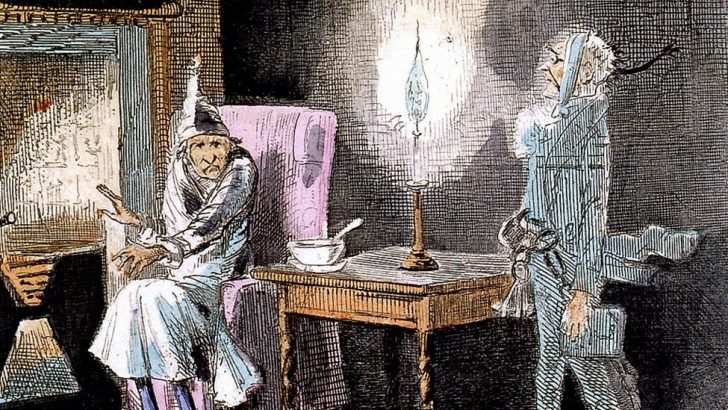It’s now 175 years since Charles Dickens published his phenomenally successful A Christmas Carol, in 1843 – so successful that it has almost come to define modern Christmas. It has spawned endless editions and many and diverse movie versions, and its allusions have gone into the language: we all know what a ‘Scrooge’ is, and we all think him a mean-spirited killjoy for his catchphrase, “bah! Humbug!”
Dickens wrote four more Christmas books, but none ever reached the iconic status of A Christmas Carol, with its recognisable characters of the poor but good Cratchit family with their disabled son, Tiny Tim, pitted against the horrible slave-driver Scrooge, who, when asked for charity replies that there are prisons and workhouses aplenty for those in need.
Who could not cheer for the sweet-natured and amiable Cratchits against the dastardly – and of course lonely – Ebenezer Scrooge?
Dickens himself admitted that he had over-egged the morality of the tale – he even described it as a “sledgehammer”, driving home his message, which to some extent, was a sermon against the Protestant work ethic which had traditionally frowned upon holiday merriment. (Some ultra-Protestant sects, such as the Plymouth Brethern, do not celebrate Christmas to this day, considering it more pagan than Christian.) Dickens recognised that A Christmas Carol was a form of propaganda: on the positive side, it was propaganda for kindness and thought for others – “Many thousands are in want of common necessaries, hundreds of thousands are in want of common comforts”, as the reader is reminded.
Truthful
On the somewhat more questionable side, it was propaganda for easy sentimentality which is not really truthful; characters like Scrooge seldom suddenly change overnight from nasty old misers to jovial philanthropists.
But it is written so engagingly, with Dickens’ genius for storytelling and charm, that it would take a heart of stone not to be impressed by it.
Still, while admiring A Christmas Carol, I retain an element of scepticism – not so much about the story itself, as about the way it has been manipulated over the past 175 years to create a phoney, slightly blackmailing approach to spending at Christmas.
Yes, we should all be kind and generous to those less fortunate, but Christmas is not just sentimental Victoriana: for Christians, it’s essentially about the Nativity, and in Dickens’ world, that aspect of Christmas scarcely ever appears.
A spurned opportunity to remember Eva
It was disappointing to learn that the Irish-born poet, Eva Gore-Booth, had been rejected for a “blue plaque” commemorating her life in England. Described as “an Edwardian trade unionist and suffragette”, Eva was deemed not famous enough by English Heritage, the body that makes these decisions.
In Ireland, Eva is of course very well known not just for her poetry, but as the sister of Constance Markievicz, who, on December 14, 1918, was the first woman to be elected to the House of Commons.
Eva, the younger sister, was a gentle, spiritual person, very committed to the cause of Christian socialism and to women’s suffrage and equality, who lived for most of her adult life in Manchester with her companion Esther Roper. Yeats’s wonderful poem ‘In Memory of Eva Gore-Booth and Con Markievicz’ opens with those lovely lines recalling the sisters at Lissadell in Sligo: “The light of evening, Lissadell/Great windows open to the south/Two girls in silk kimonos/ Both beautiful, one a gazelle.”
Monologue
Eva died in 1926, aged 56, to the desolation of her sister Constance. She is buried at St John’s Church, Hampstead, North London, which has a noted graveyard, part of a heritage tour. I’ve written a monologue about Constance’s letters to Eva, ‘Dearest Old Darling’, and when it was performed at the Irish Embassy in London last week (by Jeananne Crowley), the Vicar of Hampstead attended – almost on behalf of Eva.
There’s a good biography of Eva Gore-Booth, An Image of Such Politics, by Sonja Tiernan.
I heard it suggested that the rejection by English Heritage might have been anti-Irish, but I think it is more likely to be down to the cult of celebrity. Eva Gore-Booth doesn’t have enough of the ‘celeb’ factor now.
Others who were very famous in their day were also turned down on the grounds that to the modern eye, they are now too obscure: the once-renowned Hollywood matinée idol Ronald Colman and the once-celebrated test cricketer Albert Trott were similarly rejected. Whereas Peter Cushing, the horror-movie star, and Mary Travers, who was the author of Mary Poppins and herself the subject of a movie, were accepted for blue plaque commemoration.


 Mary Kenny
Mary Kenny A Christmas Carol
A Christmas Carol 